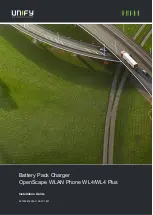
Model Number
Input Voltage
Maximum Input Current(Max.)
Voltage Charging
Selectable Charging Current
Battery Capacity & Battery Type
Over-Temperature Protection
Reverse-Polarity Protection
Short-Circuit Protection
No-Load Protection
Dimension / Weight
Operating Temp / Humidity
Storage Temp / Humidity
Safety / EMC Approvals
Wrong-Battery Protection
110 VAC / 230 VAC
GP - CZ1206
110 VAC / 2.5A, 230 VAC / 1.3A (Max.)
14.7 VDC for Snow Mode
14.4 VDC for Normal Mode
200 × 90 × 44.8 (mm) / 0.7 kg (Max)
CE / FCC / ETL / GOST / RCM
-20 ~ +50 °C / 95%
-20 ~ +85 °C / 10 ~ 95% RH
1A for Motorcycle
4A for Car / Van
6A for Truck / RV
YES
Automatic power reduction at high ambient temperature.
YES
No charging, the charge-indicating LED is off.
YES
No charging, the charge-indicating LED is off.
YES
If the battery produces an unusual voltage to the charger, then there
will be no charging and LED will not illuminate.
YES
Standby mode without any charging.
3 ~ 200 Ah, 12V
Lead-Acid
(Wet, MF,AGM, GEL)
Snow Mode
Normal Mode
Float
Desulphation
Diagnosis
Bulk
Absorption
Supervision
Float
Current
Voltage
Time
Scooter
Motorcycle
Car / Van
Truck / RV
Bicycle
Scooter
ATV
Snowmobile
【
Wide-Range Charging
】
Mode Switch
(Non LED)
This switch selects operating modes among standby, scooter / ATV, motorcycle, car / van, and
truck / RV.
Snow Switch
(Green LED)
Product Features
Specifications
CHARGING CURVE
Operating Procedure
Selective Switches
a. Before charging the battery installed in a vehicle, please turn off all the electrical equipment including lights and
other accessories connected to the vehicle.
b. Please identify the polarity of the battery: the POSITIVE (POS, P, +) and NEGATIVE (NEG, N, –) pole.
c. Please inspect which battery pole is grounded (connected to the vehicle chassis). The negative pole is usually
(but not always) grounded.
d. For charging a battery installed in a vehicle, please connect the POSITIVE (RED) and NEGATIVE (BLACK) clip
of the charger to the POSITIVE (+) and NEGATIVE (-) pole (or the vehicle chassis) of the battery respectively.
Please ensure the NEGATIVE (BLACK) clip should not be located near the fuel-pipe, carburetor and fuel
tubess Sheet-metal parts should be free from any clip.
e. For charging the battery which is not installed in a vehicle, please connect the RED and BLACK clip to the
POSITIVE and NEGATIVE pole respectively.
f. After plugging the AC power cord of the charger into the AC outlet, all charge-indicating LEDs
scanned successively.
g. Press the mode button to select vehicle type. This sets the battery maximum charging current (refer to
specifications).
This switch selects operating modes among Snow mode (14.7V or 29.4V ) and normal mode
(14.4V or 28.8V ).
Snow mode is proposed for AGM batteries or low temperatures.
Please follow the charging instructions of battery manufacturers.
Charging Current Offered by GP - CZ1206
Green
Green
Green
3 ~ 20 Ah (7 Ah)
14 ~ 80 Ah (55 Ah)
20 ~ 150 Ah (95 Ah)
Max 60 Ah
Max 150 Ah
Max 200 Ah
3 ~ 20 hrs (7 hrs)
3 ~ 20 hrs (14 hrs)
3 ~ 25 hrs (16 hrs)
Charging Current
LED Color
Battery Capacity
(typical capacity)
Battery Capacity
(maintenance)
80% Charging Time
(typical time)
1A for Scooter / ATV
4A for Motorcycle
6A for Car / Van
Blue
Red
Charge-indicating
Signal
Fault-indicating
Signal
LED is off: Standby mode.
LED is blinking: Charging is progressing.
LED is on: Charging has been completed.
LED is off: No fault.
LED is blinking: Battery is unstable.
LED is on: Battery is malfunctioning or charger is damaged.
【
CHARGING STEPS
】
【
EXPLANATION OF CHARGING STEPS
】
1. Desulphation/Desulfurization:
Desulphation/Desulfurization revives the battery via a series of current pulses dissolving sulfur from the internal
battery poles to activate chemical reaction.
2. Diagnosis:
The charging current is set to a relatively low level while the microcontroller is diagnosing physical
conditions of the battery.
3. Bulk Charging:
This is a high current charge to minimise charge time.
4. Absorption:
In this stage, the battery voltage is returned to its normal fully charged level and the charging
current is gradually decaying to nil.
5. Supervision:
The microcontroller supervises the voltage decline of the fully charged battery from its normal level to its floating
level.
6. Float Charging:
The battery voltage is maintained at its floating level by the charger via supplying an intermittently minimal
charging current.
• Latest technology switchmode design circuitry meets safety approvals
• Spark free circuitry prevents sparks on connection and disconnection
• Low ripple current design prevents heat and gas build-up from batteries
• High efficiency (over 80%), fan-less design
• Internal temperature shielded unit keeps case cool
• Three options for charging current
• Robust design protects unit in abnormal situations.
• 6 charging steps aids and facilitates battery chemical reaction extending battery life
• Inbuilt active PFC circuitry PFC >0.95 (optional)
h. Select Snow mode for charging at 14.7 or 29.4V for AGM batteries, or where the ambient temperature is below
0º C.
i. If the charging LED continually blinks, the battery is being charged. When the charging LED is permanently on,
then the battery is fully charged.
j. If the fault indicator LED blinks, or is permanently on, then the battery will not accept a charge.




















